Corporate Finance Information 2022
VerifiedAdded on 2022/09/28
|10
|2684
|23
AI Summary
Contribute Materials
Your contribution can guide someone’s learning journey. Share your
documents today.

Running Head: CORPORATE FINANCE 1
CORPORATE FINANCE
CORPORATE FINANCE
Secure Best Marks with AI Grader
Need help grading? Try our AI Grader for instant feedback on your assignments.
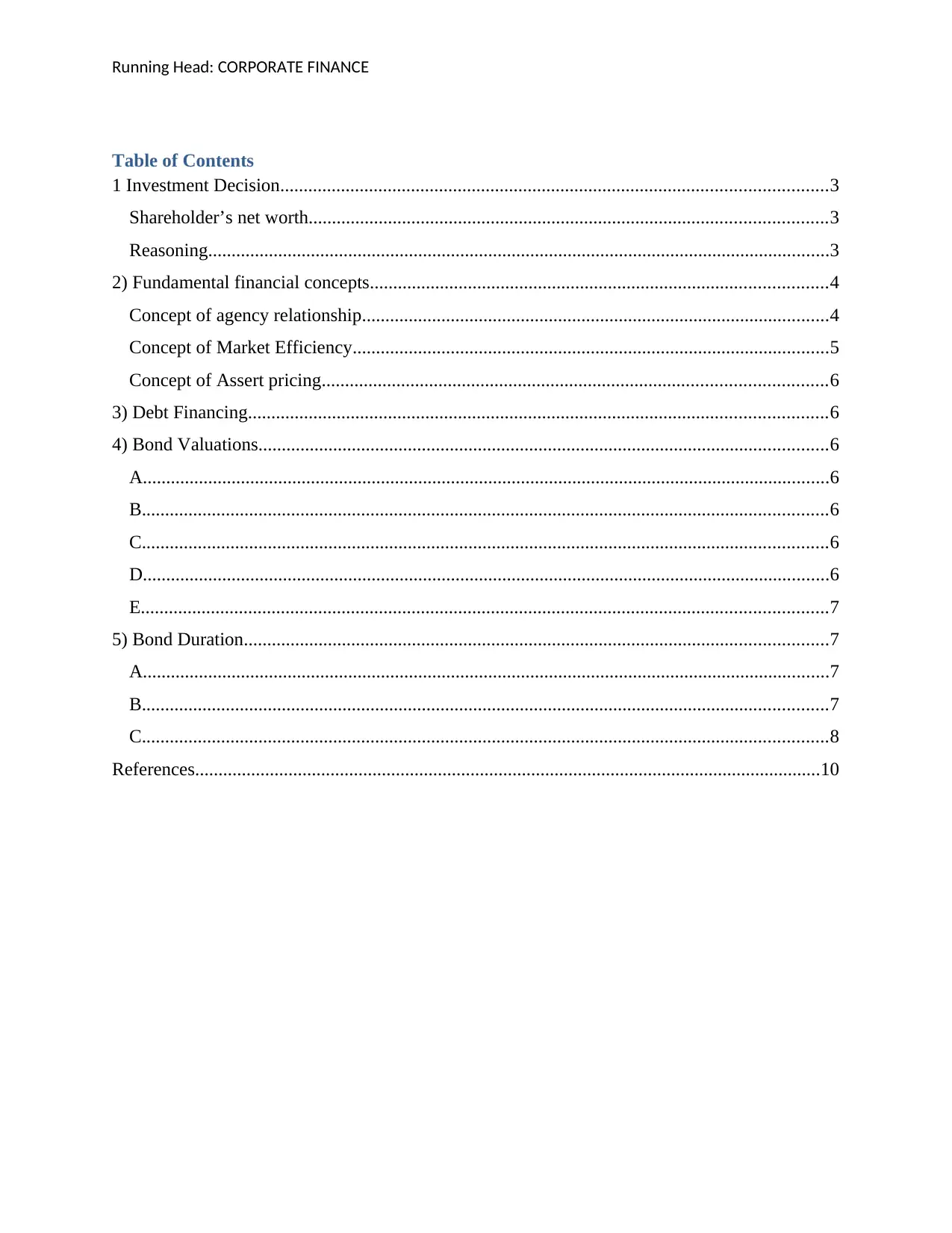
Running Head: CORPORATE FINANCE
Table of Contents
1 Investment Decision.....................................................................................................................3
Shareholder’s net worth...............................................................................................................3
Reasoning.....................................................................................................................................3
2) Fundamental financial concepts..................................................................................................4
Concept of agency relationship....................................................................................................4
Concept of Market Efficiency......................................................................................................5
Concept of Assert pricing............................................................................................................6
3) Debt Financing............................................................................................................................6
4) Bond Valuations..........................................................................................................................6
A...................................................................................................................................................6
B...................................................................................................................................................6
C...................................................................................................................................................6
D...................................................................................................................................................6
E...................................................................................................................................................7
5) Bond Duration.............................................................................................................................7
A...................................................................................................................................................7
B...................................................................................................................................................7
C...................................................................................................................................................8
References......................................................................................................................................10
Table of Contents
1 Investment Decision.....................................................................................................................3
Shareholder’s net worth...............................................................................................................3
Reasoning.....................................................................................................................................3
2) Fundamental financial concepts..................................................................................................4
Concept of agency relationship....................................................................................................4
Concept of Market Efficiency......................................................................................................5
Concept of Assert pricing............................................................................................................6
3) Debt Financing............................................................................................................................6
4) Bond Valuations..........................................................................................................................6
A...................................................................................................................................................6
B...................................................................................................................................................6
C...................................................................................................................................................6
D...................................................................................................................................................6
E...................................................................................................................................................7
5) Bond Duration.............................................................................................................................7
A...................................................................................................................................................7
B...................................................................................................................................................7
C...................................................................................................................................................8
References......................................................................................................................................10
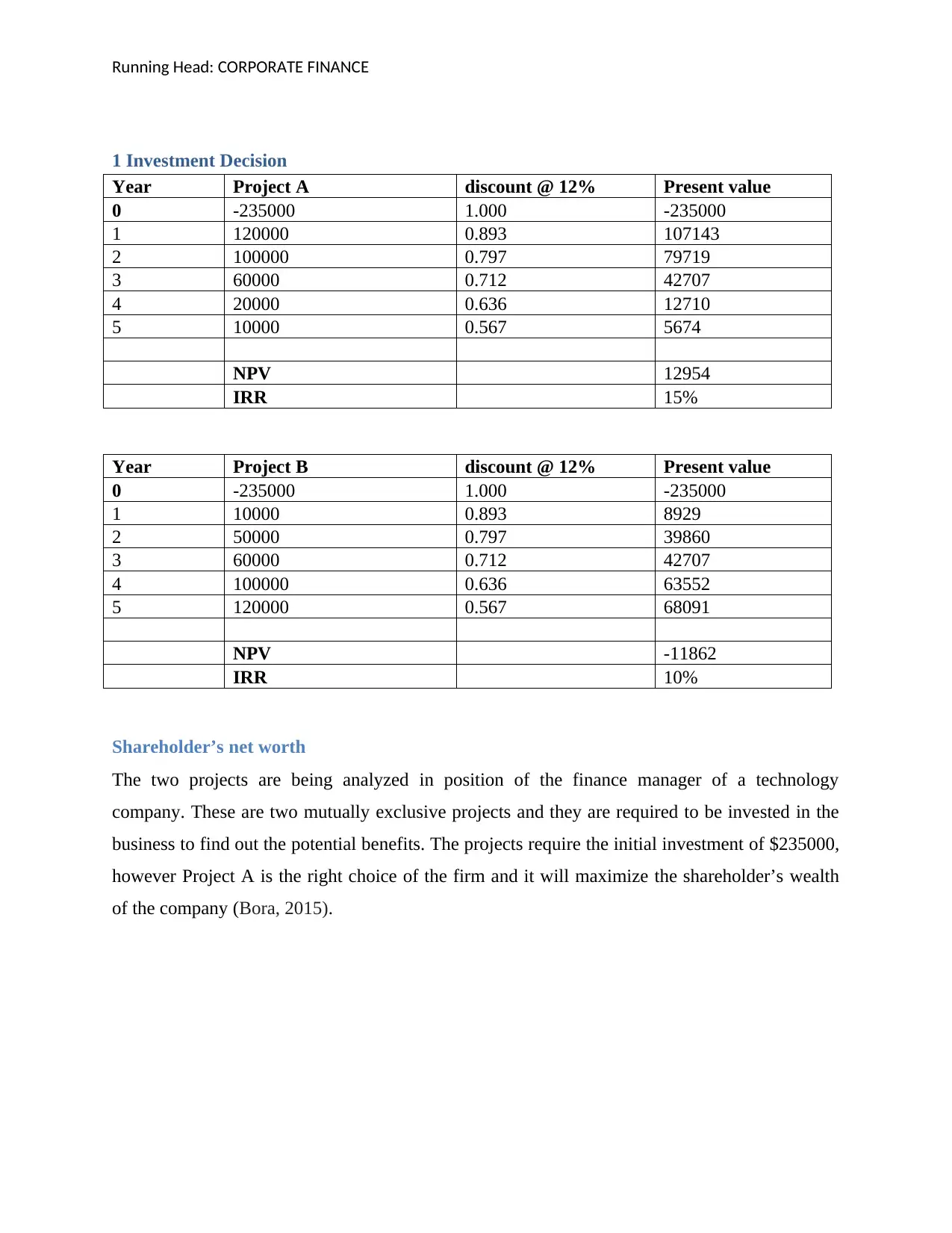
Running Head: CORPORATE FINANCE
1 Investment Decision
Year Project A discount @ 12% Present value
0 -235000 1.000 -235000
1 120000 0.893 107143
2 100000 0.797 79719
3 60000 0.712 42707
4 20000 0.636 12710
5 10000 0.567 5674
NPV 12954
IRR 15%
Year Project B discount @ 12% Present value
0 -235000 1.000 -235000
1 10000 0.893 8929
2 50000 0.797 39860
3 60000 0.712 42707
4 100000 0.636 63552
5 120000 0.567 68091
NPV -11862
IRR 10%
Shareholder’s net worth
The two projects are being analyzed in position of the finance manager of a technology
company. These are two mutually exclusive projects and they are required to be invested in the
business to find out the potential benefits. The projects require the initial investment of $235000,
however Project A is the right choice of the firm and it will maximize the shareholder’s wealth
of the company (Bora, 2015).
1 Investment Decision
Year Project A discount @ 12% Present value
0 -235000 1.000 -235000
1 120000 0.893 107143
2 100000 0.797 79719
3 60000 0.712 42707
4 20000 0.636 12710
5 10000 0.567 5674
NPV 12954
IRR 15%
Year Project B discount @ 12% Present value
0 -235000 1.000 -235000
1 10000 0.893 8929
2 50000 0.797 39860
3 60000 0.712 42707
4 100000 0.636 63552
5 120000 0.567 68091
NPV -11862
IRR 10%
Shareholder’s net worth
The two projects are being analyzed in position of the finance manager of a technology
company. These are two mutually exclusive projects and they are required to be invested in the
business to find out the potential benefits. The projects require the initial investment of $235000,
however Project A is the right choice of the firm and it will maximize the shareholder’s wealth
of the company (Bora, 2015).
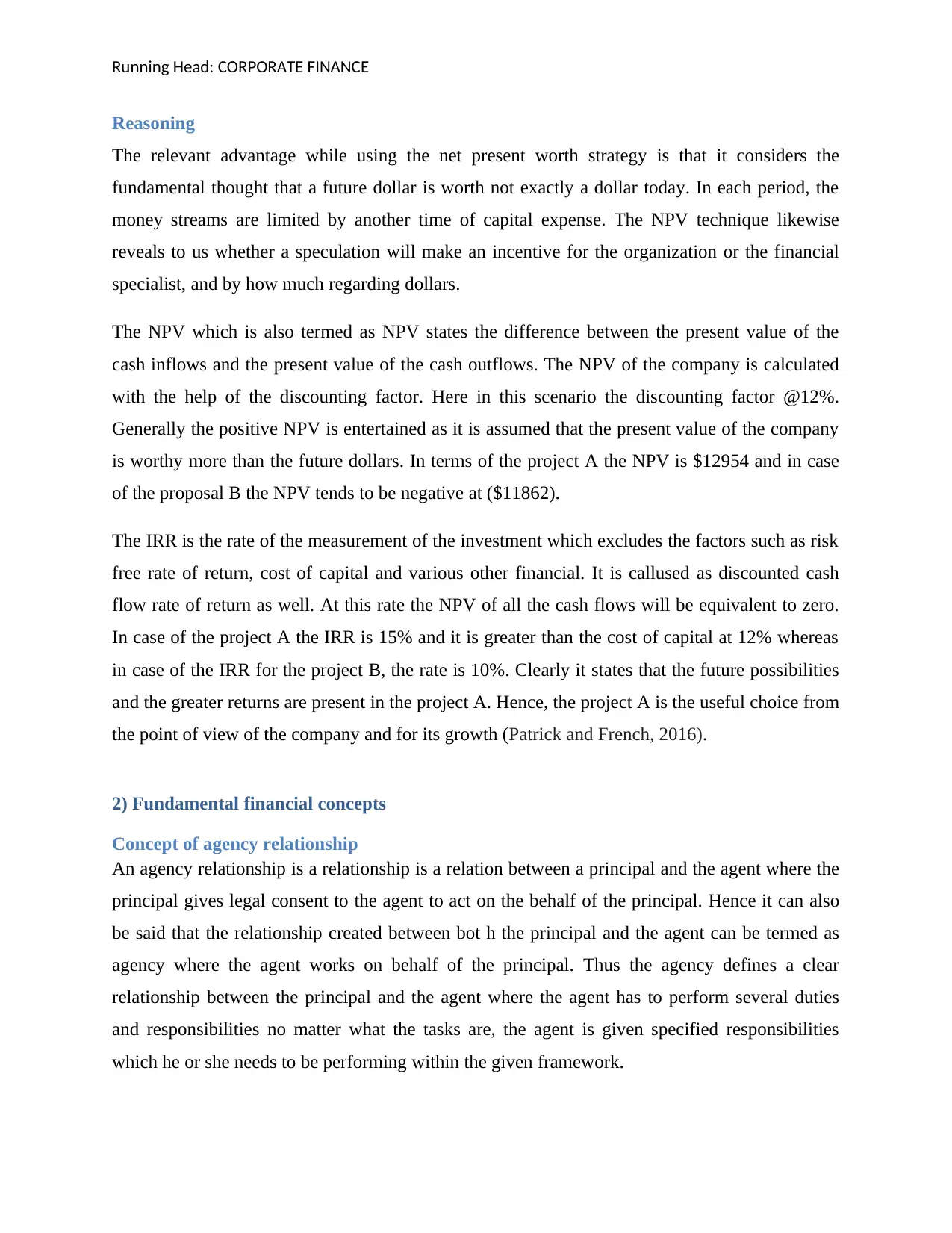
Running Head: CORPORATE FINANCE
Reasoning
The relevant advantage while using the net present worth strategy is that it considers the
fundamental thought that a future dollar is worth not exactly a dollar today. In each period, the
money streams are limited by another time of capital expense. The NPV technique likewise
reveals to us whether a speculation will make an incentive for the organization or the financial
specialist, and by how much regarding dollars.
The NPV which is also termed as NPV states the difference between the present value of the
cash inflows and the present value of the cash outflows. The NPV of the company is calculated
with the help of the discounting factor. Here in this scenario the discounting factor @12%.
Generally the positive NPV is entertained as it is assumed that the present value of the company
is worthy more than the future dollars. In terms of the project A the NPV is $12954 and in case
of the proposal B the NPV tends to be negative at ($11862).
The IRR is the rate of the measurement of the investment which excludes the factors such as risk
free rate of return, cost of capital and various other financial. It is callused as discounted cash
flow rate of return as well. At this rate the NPV of all the cash flows will be equivalent to zero.
In case of the project A the IRR is 15% and it is greater than the cost of capital at 12% whereas
in case of the IRR for the project B, the rate is 10%. Clearly it states that the future possibilities
and the greater returns are present in the project A. Hence, the project A is the useful choice from
the point of view of the company and for its growth (Patrick and French, 2016).
2) Fundamental financial concepts
Concept of agency relationship
An agency relationship is a relationship is a relation between a principal and the agent where the
principal gives legal consent to the agent to act on the behalf of the principal. Hence it can also
be said that the relationship created between bot h the principal and the agent can be termed as
agency where the agent works on behalf of the principal. Thus the agency defines a clear
relationship between the principal and the agent where the agent has to perform several duties
and responsibilities no matter what the tasks are, the agent is given specified responsibilities
which he or she needs to be performing within the given framework.
Reasoning
The relevant advantage while using the net present worth strategy is that it considers the
fundamental thought that a future dollar is worth not exactly a dollar today. In each period, the
money streams are limited by another time of capital expense. The NPV technique likewise
reveals to us whether a speculation will make an incentive for the organization or the financial
specialist, and by how much regarding dollars.
The NPV which is also termed as NPV states the difference between the present value of the
cash inflows and the present value of the cash outflows. The NPV of the company is calculated
with the help of the discounting factor. Here in this scenario the discounting factor @12%.
Generally the positive NPV is entertained as it is assumed that the present value of the company
is worthy more than the future dollars. In terms of the project A the NPV is $12954 and in case
of the proposal B the NPV tends to be negative at ($11862).
The IRR is the rate of the measurement of the investment which excludes the factors such as risk
free rate of return, cost of capital and various other financial. It is callused as discounted cash
flow rate of return as well. At this rate the NPV of all the cash flows will be equivalent to zero.
In case of the project A the IRR is 15% and it is greater than the cost of capital at 12% whereas
in case of the IRR for the project B, the rate is 10%. Clearly it states that the future possibilities
and the greater returns are present in the project A. Hence, the project A is the useful choice from
the point of view of the company and for its growth (Patrick and French, 2016).
2) Fundamental financial concepts
Concept of agency relationship
An agency relationship is a relationship is a relation between a principal and the agent where the
principal gives legal consent to the agent to act on the behalf of the principal. Hence it can also
be said that the relationship created between bot h the principal and the agent can be termed as
agency where the agent works on behalf of the principal. Thus the agency defines a clear
relationship between the principal and the agent where the agent has to perform several duties
and responsibilities no matter what the tasks are, the agent is given specified responsibilities
which he or she needs to be performing within the given framework.
Secure Best Marks with AI Grader
Need help grading? Try our AI Grader for instant feedback on your assignments.
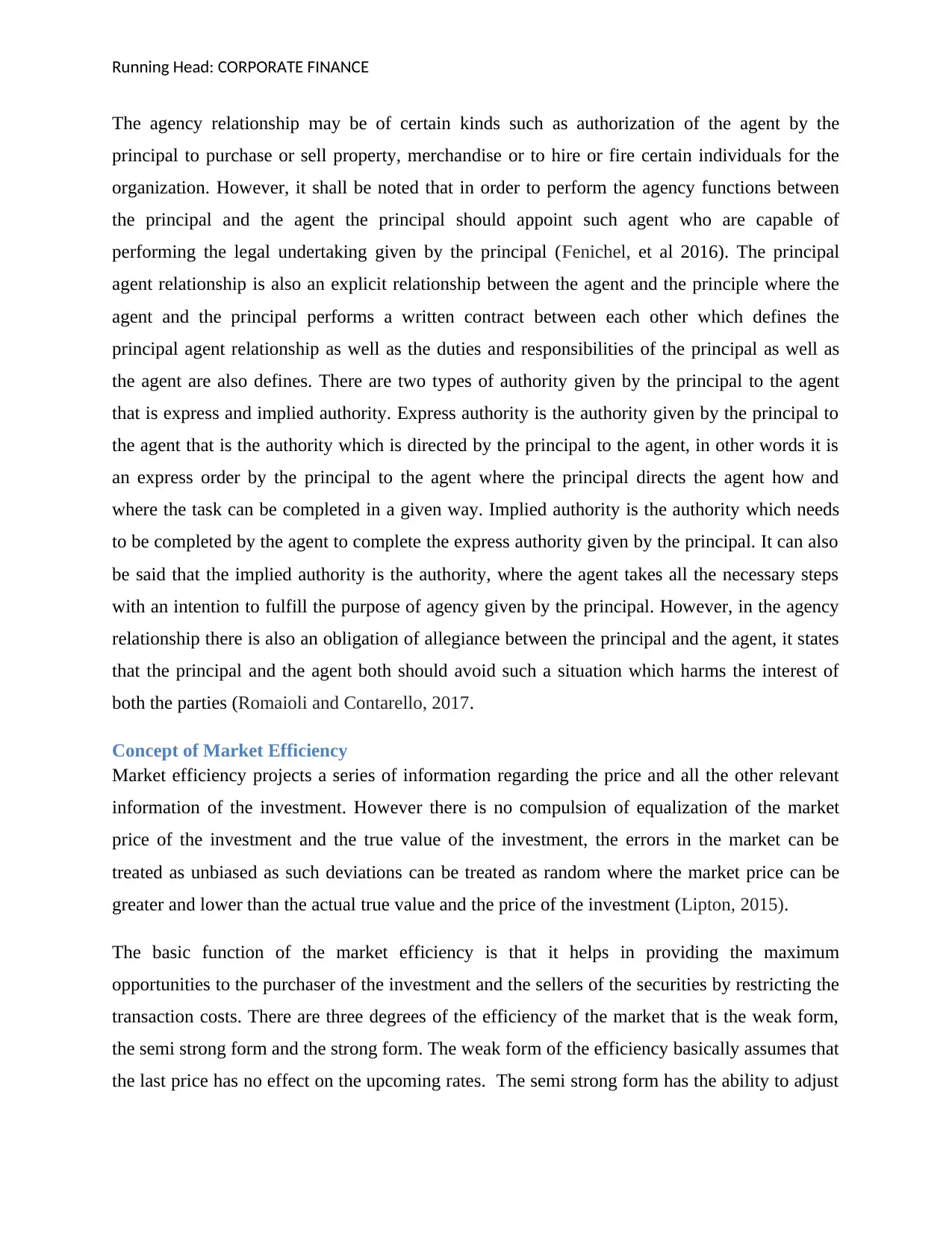
Running Head: CORPORATE FINANCE
The agency relationship may be of certain kinds such as authorization of the agent by the
principal to purchase or sell property, merchandise or to hire or fire certain individuals for the
organization. However, it shall be noted that in order to perform the agency functions between
the principal and the agent the principal should appoint such agent who are capable of
performing the legal undertaking given by the principal (Fenichel, et al 2016). The principal
agent relationship is also an explicit relationship between the agent and the principle where the
agent and the principal performs a written contract between each other which defines the
principal agent relationship as well as the duties and responsibilities of the principal as well as
the agent are also defines. There are two types of authority given by the principal to the agent
that is express and implied authority. Express authority is the authority given by the principal to
the agent that is the authority which is directed by the principal to the agent, in other words it is
an express order by the principal to the agent where the principal directs the agent how and
where the task can be completed in a given way. Implied authority is the authority which needs
to be completed by the agent to complete the express authority given by the principal. It can also
be said that the implied authority is the authority, where the agent takes all the necessary steps
with an intention to fulfill the purpose of agency given by the principal. However, in the agency
relationship there is also an obligation of allegiance between the principal and the agent, it states
that the principal and the agent both should avoid such a situation which harms the interest of
both the parties (Romaioli and Contarello, 2017.
Concept of Market Efficiency
Market efficiency projects a series of information regarding the price and all the other relevant
information of the investment. However there is no compulsion of equalization of the market
price of the investment and the true value of the investment, the errors in the market can be
treated as unbiased as such deviations can be treated as random where the market price can be
greater and lower than the actual true value and the price of the investment (Lipton, 2015).
The basic function of the market efficiency is that it helps in providing the maximum
opportunities to the purchaser of the investment and the sellers of the securities by restricting the
transaction costs. There are three degrees of the efficiency of the market that is the weak form,
the semi strong form and the strong form. The weak form of the efficiency basically assumes that
the last price has no effect on the upcoming rates. The semi strong form has the ability to adjust
The agency relationship may be of certain kinds such as authorization of the agent by the
principal to purchase or sell property, merchandise or to hire or fire certain individuals for the
organization. However, it shall be noted that in order to perform the agency functions between
the principal and the agent the principal should appoint such agent who are capable of
performing the legal undertaking given by the principal (Fenichel, et al 2016). The principal
agent relationship is also an explicit relationship between the agent and the principle where the
agent and the principal performs a written contract between each other which defines the
principal agent relationship as well as the duties and responsibilities of the principal as well as
the agent are also defines. There are two types of authority given by the principal to the agent
that is express and implied authority. Express authority is the authority given by the principal to
the agent that is the authority which is directed by the principal to the agent, in other words it is
an express order by the principal to the agent where the principal directs the agent how and
where the task can be completed in a given way. Implied authority is the authority which needs
to be completed by the agent to complete the express authority given by the principal. It can also
be said that the implied authority is the authority, where the agent takes all the necessary steps
with an intention to fulfill the purpose of agency given by the principal. However, in the agency
relationship there is also an obligation of allegiance between the principal and the agent, it states
that the principal and the agent both should avoid such a situation which harms the interest of
both the parties (Romaioli and Contarello, 2017.
Concept of Market Efficiency
Market efficiency projects a series of information regarding the price and all the other relevant
information of the investment. However there is no compulsion of equalization of the market
price of the investment and the true value of the investment, the errors in the market can be
treated as unbiased as such deviations can be treated as random where the market price can be
greater and lower than the actual true value and the price of the investment (Lipton, 2015).
The basic function of the market efficiency is that it helps in providing the maximum
opportunities to the purchaser of the investment and the sellers of the securities by restricting the
transaction costs. There are three degrees of the efficiency of the market that is the weak form,
the semi strong form and the strong form. The weak form of the efficiency basically assumes that
the last price has no effect on the upcoming rates. The semi strong form has the ability to adjust
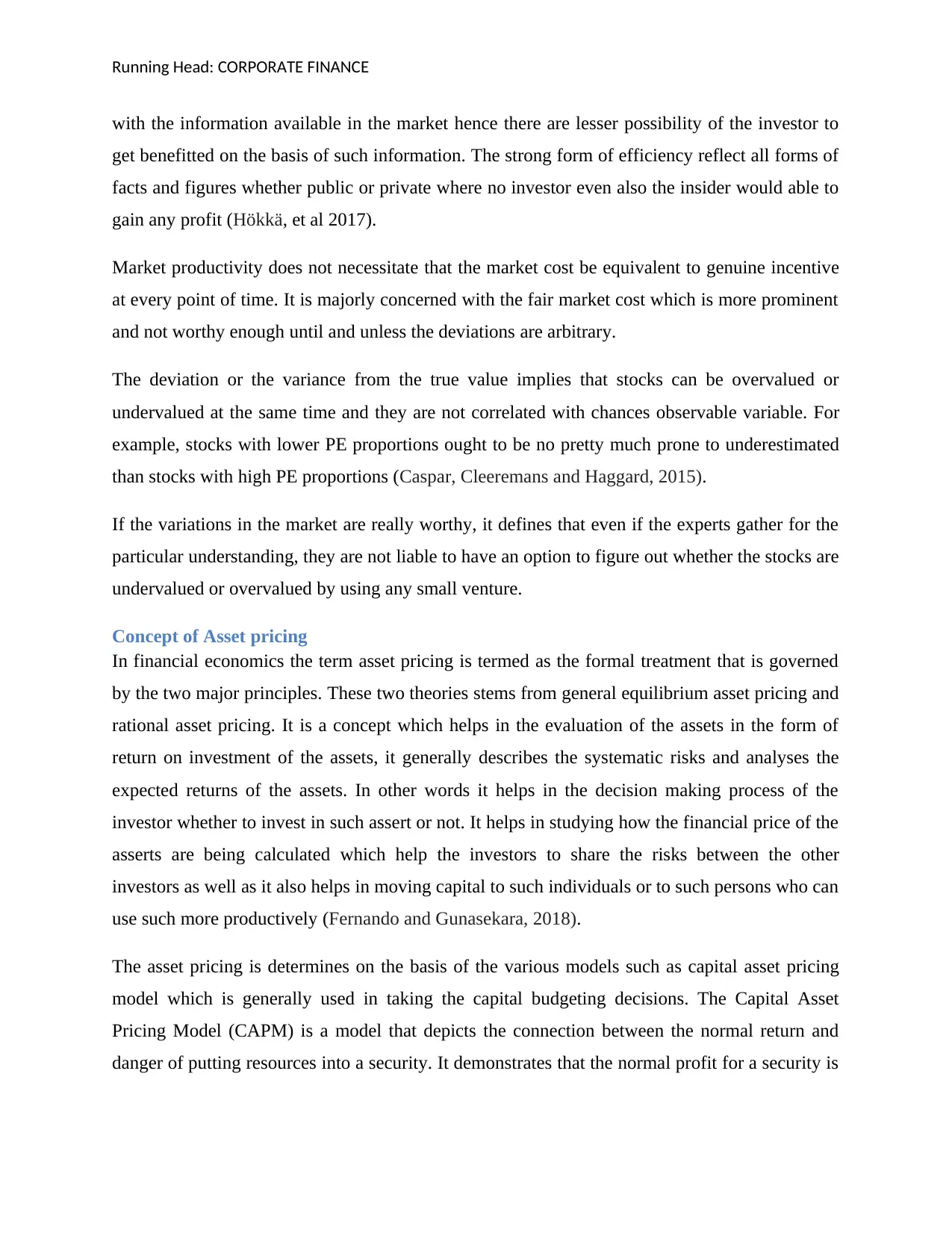
Running Head: CORPORATE FINANCE
with the information available in the market hence there are lesser possibility of the investor to
get benefitted on the basis of such information. The strong form of efficiency reflect all forms of
facts and figures whether public or private where no investor even also the insider would able to
gain any profit (Hökkä, et al 2017).
Market productivity does not necessitate that the market cost be equivalent to genuine incentive
at every point of time. It is majorly concerned with the fair market cost which is more prominent
and not worthy enough until and unless the deviations are arbitrary.
The deviation or the variance from the true value implies that stocks can be overvalued or
undervalued at the same time and they are not correlated with chances observable variable. For
example, stocks with lower PE proportions ought to be no pretty much prone to underestimated
than stocks with high PE proportions (Caspar, Cleeremans and Haggard, 2015).
If the variations in the market are really worthy, it defines that even if the experts gather for the
particular understanding, they are not liable to have an option to figure out whether the stocks are
undervalued or overvalued by using any small venture.
Concept of Asset pricing
In financial economics the term asset pricing is termed as the formal treatment that is governed
by the two major principles. These two theories stems from general equilibrium asset pricing and
rational asset pricing. It is a concept which helps in the evaluation of the assets in the form of
return on investment of the assets, it generally describes the systematic risks and analyses the
expected returns of the assets. In other words it helps in the decision making process of the
investor whether to invest in such assert or not. It helps in studying how the financial price of the
asserts are being calculated which help the investors to share the risks between the other
investors as well as it also helps in moving capital to such individuals or to such persons who can
use such more productively (Fernando and Gunasekara, 2018).
The asset pricing is determines on the basis of the various models such as capital asset pricing
model which is generally used in taking the capital budgeting decisions. The Capital Asset
Pricing Model (CAPM) is a model that depicts the connection between the normal return and
danger of putting resources into a security. It demonstrates that the normal profit for a security is
with the information available in the market hence there are lesser possibility of the investor to
get benefitted on the basis of such information. The strong form of efficiency reflect all forms of
facts and figures whether public or private where no investor even also the insider would able to
gain any profit (Hökkä, et al 2017).
Market productivity does not necessitate that the market cost be equivalent to genuine incentive
at every point of time. It is majorly concerned with the fair market cost which is more prominent
and not worthy enough until and unless the deviations are arbitrary.
The deviation or the variance from the true value implies that stocks can be overvalued or
undervalued at the same time and they are not correlated with chances observable variable. For
example, stocks with lower PE proportions ought to be no pretty much prone to underestimated
than stocks with high PE proportions (Caspar, Cleeremans and Haggard, 2015).
If the variations in the market are really worthy, it defines that even if the experts gather for the
particular understanding, they are not liable to have an option to figure out whether the stocks are
undervalued or overvalued by using any small venture.
Concept of Asset pricing
In financial economics the term asset pricing is termed as the formal treatment that is governed
by the two major principles. These two theories stems from general equilibrium asset pricing and
rational asset pricing. It is a concept which helps in the evaluation of the assets in the form of
return on investment of the assets, it generally describes the systematic risks and analyses the
expected returns of the assets. In other words it helps in the decision making process of the
investor whether to invest in such assert or not. It helps in studying how the financial price of the
asserts are being calculated which help the investors to share the risks between the other
investors as well as it also helps in moving capital to such individuals or to such persons who can
use such more productively (Fernando and Gunasekara, 2018).
The asset pricing is determines on the basis of the various models such as capital asset pricing
model which is generally used in taking the capital budgeting decisions. The Capital Asset
Pricing Model (CAPM) is a model that depicts the connection between the normal return and
danger of putting resources into a security. It demonstrates that the normal profit for a security is
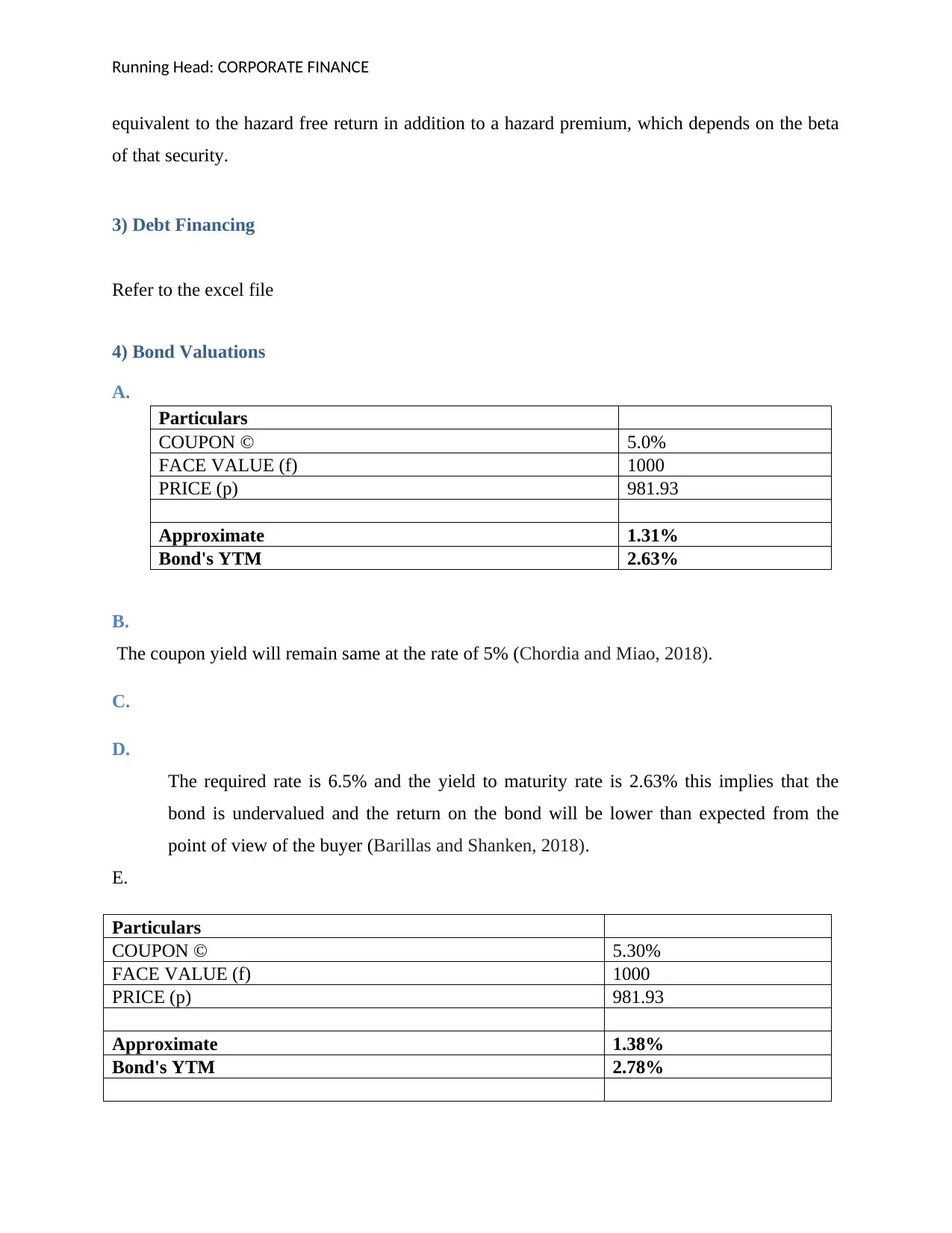
Running Head: CORPORATE FINANCE
equivalent to the hazard free return in addition to a hazard premium, which depends on the beta
of that security.
3) Debt Financing
Refer to the excel file
4) Bond Valuations
A.
Particulars
COUPON © 5.0%
FACE VALUE (f) 1000
PRICE (p) 981.93
Approximate 1.31%
Bond's YTM 2.63%
B.
The coupon yield will remain same at the rate of 5% (Chordia and Miao, 2018).
C.
D.
The required rate is 6.5% and the yield to maturity rate is 2.63% this implies that the
bond is undervalued and the return on the bond will be lower than expected from the
point of view of the buyer (Barillas and Shanken, 2018).
E.
Particulars
COUPON © 5.30%
FACE VALUE (f) 1000
PRICE (p) 981.93
Approximate 1.38%
Bond's YTM 2.78%
equivalent to the hazard free return in addition to a hazard premium, which depends on the beta
of that security.
3) Debt Financing
Refer to the excel file
4) Bond Valuations
A.
Particulars
COUPON © 5.0%
FACE VALUE (f) 1000
PRICE (p) 981.93
Approximate 1.31%
Bond's YTM 2.63%
B.
The coupon yield will remain same at the rate of 5% (Chordia and Miao, 2018).
C.
D.
The required rate is 6.5% and the yield to maturity rate is 2.63% this implies that the
bond is undervalued and the return on the bond will be lower than expected from the
point of view of the buyer (Barillas and Shanken, 2018).
E.
Particulars
COUPON © 5.30%
FACE VALUE (f) 1000
PRICE (p) 981.93
Approximate 1.38%
Bond's YTM 2.78%
Paraphrase This Document
Need a fresh take? Get an instant paraphrase of this document with our AI Paraphraser
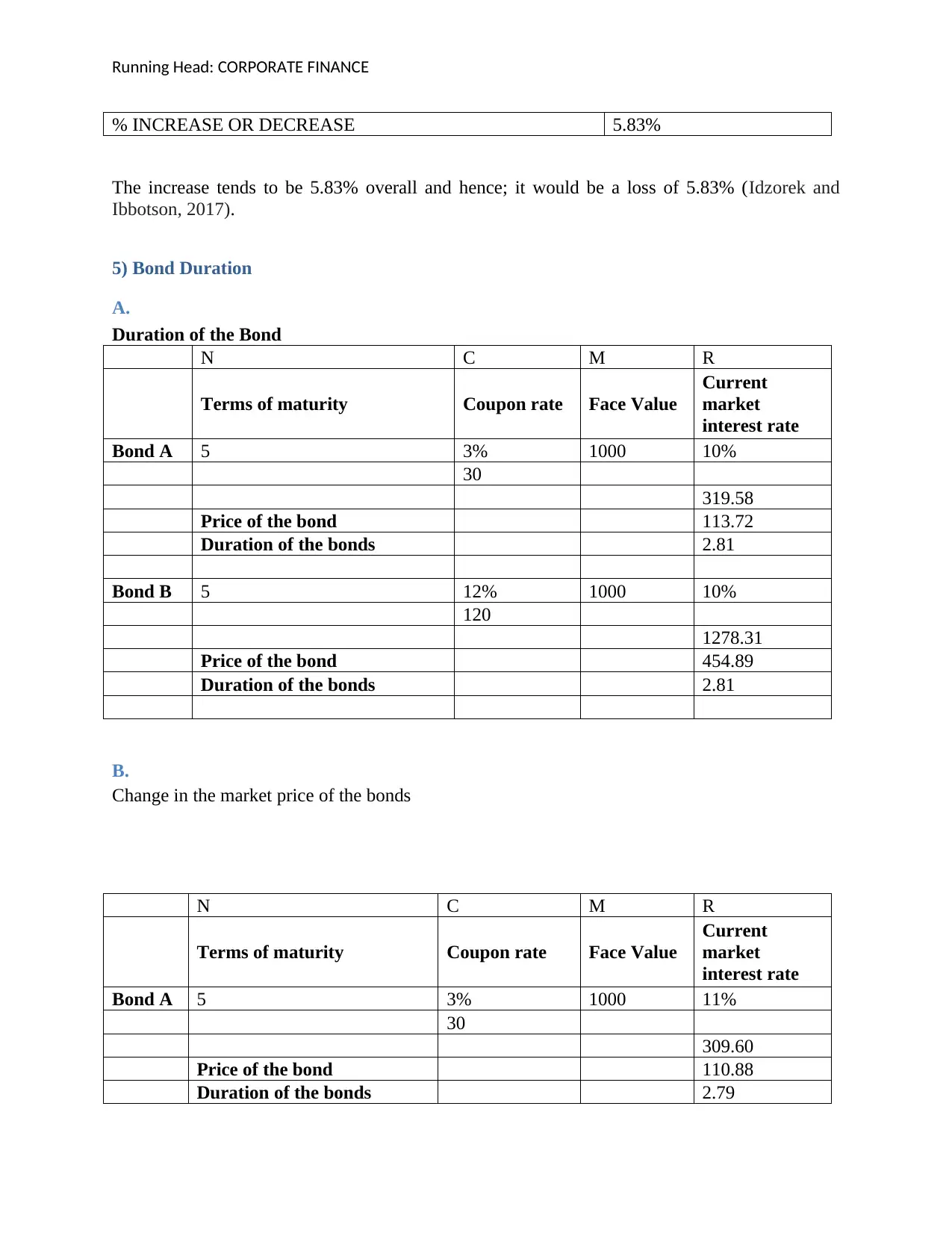
Running Head: CORPORATE FINANCE
% INCREASE OR DECREASE 5.83%
The increase tends to be 5.83% overall and hence; it would be a loss of 5.83% (Idzorek and
Ibbotson, 2017).
5) Bond Duration
A.
Duration of the Bond
N C M R
Terms of maturity Coupon rate Face Value
Current
market
interest rate
Bond A 5 3% 1000 10%
30
319.58
Price of the bond 113.72
Duration of the bonds 2.81
Bond B 5 12% 1000 10%
120
1278.31
Price of the bond 454.89
Duration of the bonds 2.81
B.
Change in the market price of the bonds
N C M R
Terms of maturity Coupon rate Face Value
Current
market
interest rate
Bond A 5 3% 1000 11%
30
309.60
Price of the bond 110.88
Duration of the bonds 2.79
% INCREASE OR DECREASE 5.83%
The increase tends to be 5.83% overall and hence; it would be a loss of 5.83% (Idzorek and
Ibbotson, 2017).
5) Bond Duration
A.
Duration of the Bond
N C M R
Terms of maturity Coupon rate Face Value
Current
market
interest rate
Bond A 5 3% 1000 10%
30
319.58
Price of the bond 113.72
Duration of the bonds 2.81
Bond B 5 12% 1000 10%
120
1278.31
Price of the bond 454.89
Duration of the bonds 2.81
B.
Change in the market price of the bonds
N C M R
Terms of maturity Coupon rate Face Value
Current
market
interest rate
Bond A 5 3% 1000 11%
30
309.60
Price of the bond 110.88
Duration of the bonds 2.79
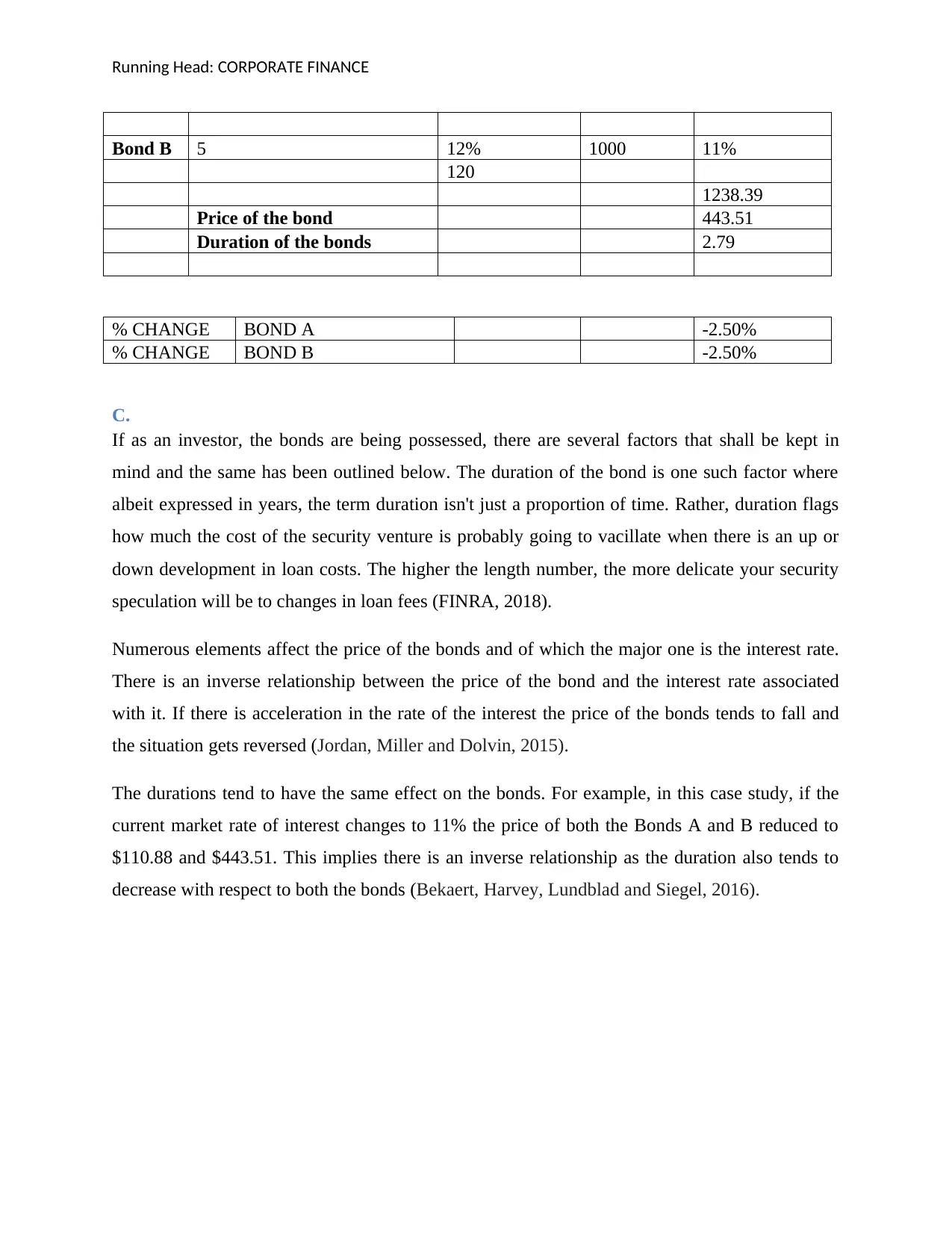
Running Head: CORPORATE FINANCE
Bond B 5 12% 1000 11%
120
1238.39
Price of the bond 443.51
Duration of the bonds 2.79
% CHANGE BOND A -2.50%
% CHANGE BOND B -2.50%
C.
If as an investor, the bonds are being possessed, there are several factors that shall be kept in
mind and the same has been outlined below. The duration of the bond is one such factor where
albeit expressed in years, the term duration isn't just a proportion of time. Rather, duration flags
how much the cost of the security venture is probably going to vacillate when there is an up or
down development in loan costs. The higher the length number, the more delicate your security
speculation will be to changes in loan fees (FINRA, 2018).
Numerous elements affect the price of the bonds and of which the major one is the interest rate.
There is an inverse relationship between the price of the bond and the interest rate associated
with it. If there is acceleration in the rate of the interest the price of the bonds tends to fall and
the situation gets reversed (Jordan, Miller and Dolvin, 2015).
The durations tend to have the same effect on the bonds. For example, in this case study, if the
current market rate of interest changes to 11% the price of both the Bonds A and B reduced to
$110.88 and $443.51. This implies there is an inverse relationship as the duration also tends to
decrease with respect to both the bonds (Bekaert, Harvey, Lundblad and Siegel, 2016).
Bond B 5 12% 1000 11%
120
1238.39
Price of the bond 443.51
Duration of the bonds 2.79
% CHANGE BOND A -2.50%
% CHANGE BOND B -2.50%
C.
If as an investor, the bonds are being possessed, there are several factors that shall be kept in
mind and the same has been outlined below. The duration of the bond is one such factor where
albeit expressed in years, the term duration isn't just a proportion of time. Rather, duration flags
how much the cost of the security venture is probably going to vacillate when there is an up or
down development in loan costs. The higher the length number, the more delicate your security
speculation will be to changes in loan fees (FINRA, 2018).
Numerous elements affect the price of the bonds and of which the major one is the interest rate.
There is an inverse relationship between the price of the bond and the interest rate associated
with it. If there is acceleration in the rate of the interest the price of the bonds tends to fall and
the situation gets reversed (Jordan, Miller and Dolvin, 2015).
The durations tend to have the same effect on the bonds. For example, in this case study, if the
current market rate of interest changes to 11% the price of both the Bonds A and B reduced to
$110.88 and $443.51. This implies there is an inverse relationship as the duration also tends to
decrease with respect to both the bonds (Bekaert, Harvey, Lundblad and Siegel, 2016).
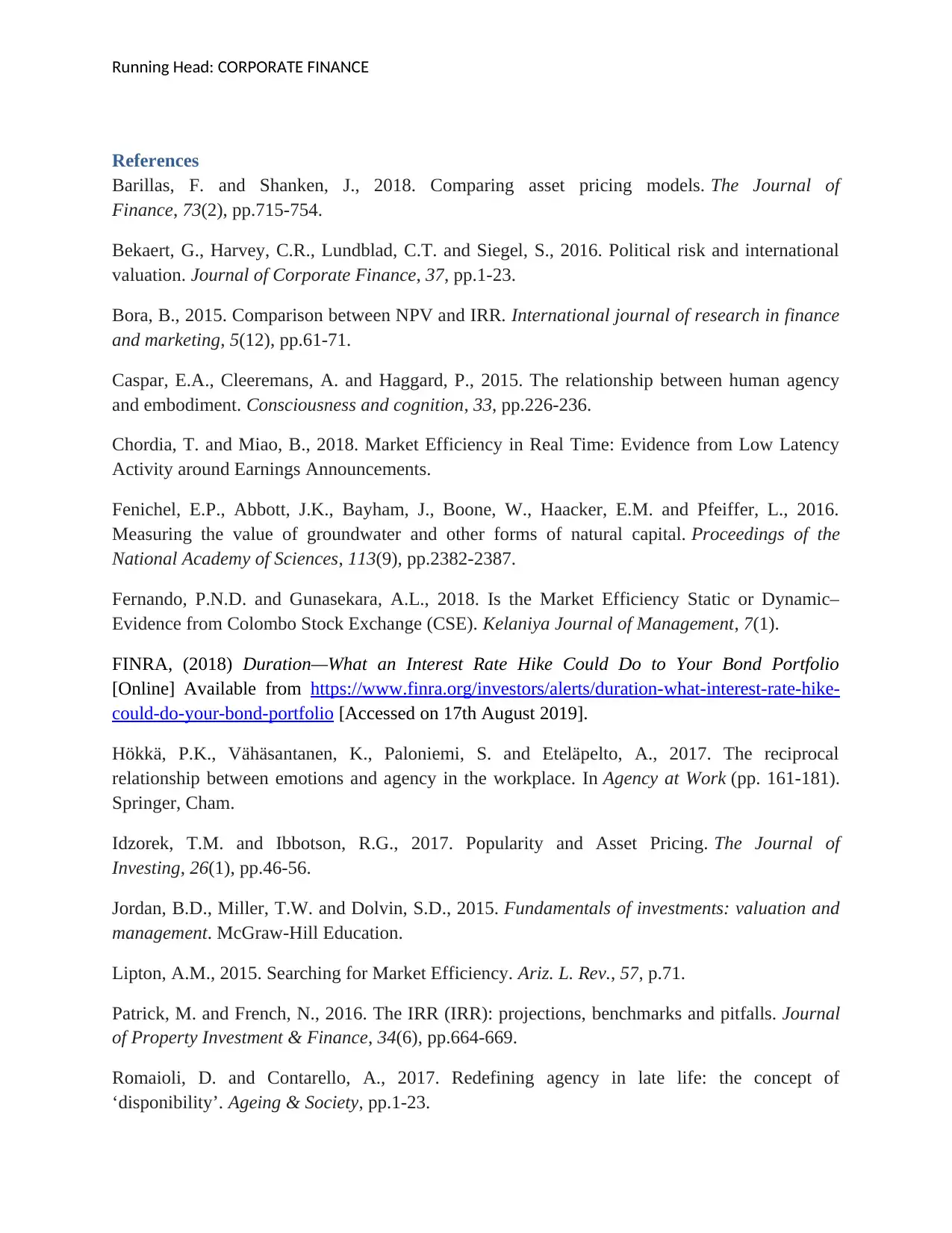
Running Head: CORPORATE FINANCE
References
Barillas, F. and Shanken, J., 2018. Comparing asset pricing models. The Journal of
Finance, 73(2), pp.715-754.
Bekaert, G., Harvey, C.R., Lundblad, C.T. and Siegel, S., 2016. Political risk and international
valuation. Journal of Corporate Finance, 37, pp.1-23.
Bora, B., 2015. Comparison between NPV and IRR. International journal of research in finance
and marketing, 5(12), pp.61-71.
Caspar, E.A., Cleeremans, A. and Haggard, P., 2015. The relationship between human agency
and embodiment. Consciousness and cognition, 33, pp.226-236.
Chordia, T. and Miao, B., 2018. Market Efficiency in Real Time: Evidence from Low Latency
Activity around Earnings Announcements.
Fenichel, E.P., Abbott, J.K., Bayham, J., Boone, W., Haacker, E.M. and Pfeiffer, L., 2016.
Measuring the value of groundwater and other forms of natural capital. Proceedings of the
National Academy of Sciences, 113(9), pp.2382-2387.
Fernando, P.N.D. and Gunasekara, A.L., 2018. Is the Market Efficiency Static or Dynamic–
Evidence from Colombo Stock Exchange (CSE). Kelaniya Journal of Management, 7(1).
FINRA, (2018) Duration—What an Interest Rate Hike Could Do to Your Bond Portfolio
[Online] Available from https://www.finra.org/investors/alerts/duration-what-interest-rate-hike-
could-do-your-bond-portfolio [Accessed on 17th August 2019].
Hökkä, P.K., Vähäsantanen, K., Paloniemi, S. and Eteläpelto, A., 2017. The reciprocal
relationship between emotions and agency in the workplace. In Agency at Work (pp. 161-181).
Springer, Cham.
Idzorek, T.M. and Ibbotson, R.G., 2017. Popularity and Asset Pricing. The Journal of
Investing, 26(1), pp.46-56.
Jordan, B.D., Miller, T.W. and Dolvin, S.D., 2015. Fundamentals of investments: valuation and
management. McGraw-Hill Education.
Lipton, A.M., 2015. Searching for Market Efficiency. Ariz. L. Rev., 57, p.71.
Patrick, M. and French, N., 2016. The IRR (IRR): projections, benchmarks and pitfalls. Journal
of Property Investment & Finance, 34(6), pp.664-669.
Romaioli, D. and Contarello, A., 2017. Redefining agency in late life: the concept of
‘disponibility’. Ageing & Society, pp.1-23.
References
Barillas, F. and Shanken, J., 2018. Comparing asset pricing models. The Journal of
Finance, 73(2), pp.715-754.
Bekaert, G., Harvey, C.R., Lundblad, C.T. and Siegel, S., 2016. Political risk and international
valuation. Journal of Corporate Finance, 37, pp.1-23.
Bora, B., 2015. Comparison between NPV and IRR. International journal of research in finance
and marketing, 5(12), pp.61-71.
Caspar, E.A., Cleeremans, A. and Haggard, P., 2015. The relationship between human agency
and embodiment. Consciousness and cognition, 33, pp.226-236.
Chordia, T. and Miao, B., 2018. Market Efficiency in Real Time: Evidence from Low Latency
Activity around Earnings Announcements.
Fenichel, E.P., Abbott, J.K., Bayham, J., Boone, W., Haacker, E.M. and Pfeiffer, L., 2016.
Measuring the value of groundwater and other forms of natural capital. Proceedings of the
National Academy of Sciences, 113(9), pp.2382-2387.
Fernando, P.N.D. and Gunasekara, A.L., 2018. Is the Market Efficiency Static or Dynamic–
Evidence from Colombo Stock Exchange (CSE). Kelaniya Journal of Management, 7(1).
FINRA, (2018) Duration—What an Interest Rate Hike Could Do to Your Bond Portfolio
[Online] Available from https://www.finra.org/investors/alerts/duration-what-interest-rate-hike-
could-do-your-bond-portfolio [Accessed on 17th August 2019].
Hökkä, P.K., Vähäsantanen, K., Paloniemi, S. and Eteläpelto, A., 2017. The reciprocal
relationship between emotions and agency in the workplace. In Agency at Work (pp. 161-181).
Springer, Cham.
Idzorek, T.M. and Ibbotson, R.G., 2017. Popularity and Asset Pricing. The Journal of
Investing, 26(1), pp.46-56.
Jordan, B.D., Miller, T.W. and Dolvin, S.D., 2015. Fundamentals of investments: valuation and
management. McGraw-Hill Education.
Lipton, A.M., 2015. Searching for Market Efficiency. Ariz. L. Rev., 57, p.71.
Patrick, M. and French, N., 2016. The IRR (IRR): projections, benchmarks and pitfalls. Journal
of Property Investment & Finance, 34(6), pp.664-669.
Romaioli, D. and Contarello, A., 2017. Redefining agency in late life: the concept of
‘disponibility’. Ageing & Society, pp.1-23.
1 out of 10
Related Documents
Your All-in-One AI-Powered Toolkit for Academic Success.
+13062052269
info@desklib.com
Available 24*7 on WhatsApp / Email
![[object Object]](/_next/static/media/star-bottom.7253800d.svg)
Unlock your academic potential
© 2024 | Zucol Services PVT LTD | All rights reserved.





